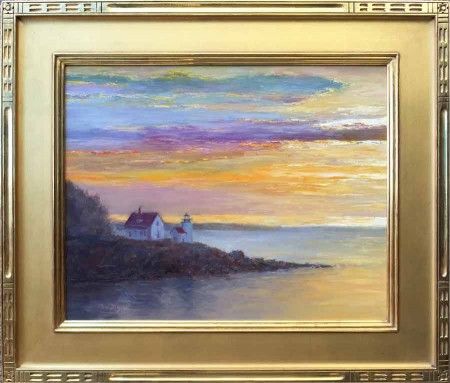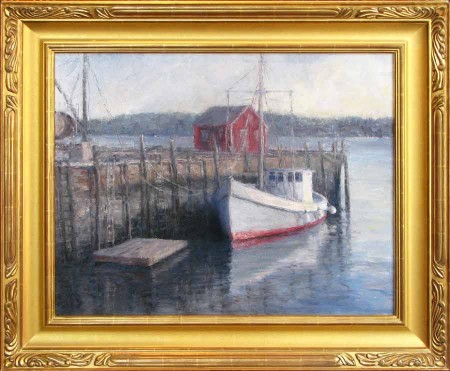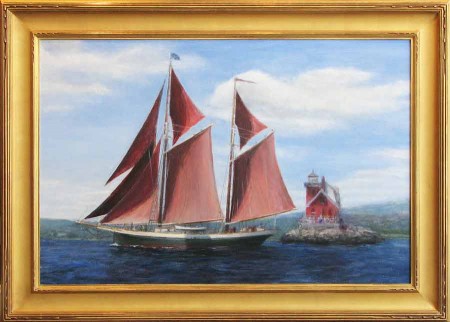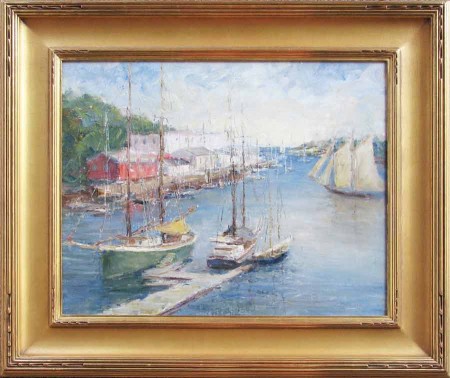Mark Daly’s appealing paintings are on view at Cincinnati Art Galleries in a show called “Memorable Impressions” that shares with viewers his own pleasures at looking. He likes looking at: sailboats, sunsets, church spires in hazy weather, city streets filling up with snow. The works are new, some as recent as three weeks before the opening of the exhibition, most from the last year or two.
Texture is important in Daly’s paintings. Brush strokes are vibrant and compelling, color itself is usually that of an inviting day. He grew up near the ocean in the northeast; these memorable impressions have never left him and apparently are refreshed with regularity. He’s also spent time at Flathead Lake near Glacier Park, which brings another kind of landscape, water-scape into view.
Daly is interesting in that he has moved from a business career of a very Cincinnati pattern, including time at Procter & Gamble, to concentrating ever more intently on being an artist. Making art has been part of his life as long as he can remember. He could always draw, he says, and credits C.W. Mundy’s book on still life painting as encouraging him to develop a focused vision. Later, he would be hugely influenced by Cincinnati-born Edward Potthast. “You can almost talk to his drawings,” he says. “He was a huge help.” Cincinnati, he feels, has a history of good artists. “We’re blessed.” He also cites Andrew Wyeth’s work as teaching him a lot about design. “I look at everything I can,” he says, meaning of course that he looks to see what he can learn.
He has found, however, that his business background makes its own contributions to his painting career. In a talk shortly after the opening of “Memorable Impressions” he discussed specific insights that transfer from one career to the other. Expert advice can be extremely helpful; it’s important to have a focused vision; seeing the truth is another of his watchwords (perhaps the most difficult?)
He also spoke of understanding the thinking process: the left brain will analyze, the right brain will experiment and innovate. He feels strongly that finding what you are good at in one area of your life can help you advance into another, new area. “The connections are there – you just have to look for them and leverage them!” He credits his Procter & Gamble background with allowing him to look at results in the way that business looks at results and therefore becoming a better painter. It’s also, perhaps, P&G that leads him to say he wants to know what people want in their art. This artist’s education certainly suggests his career interests and paths: bachelor’s degree from Cornell University’s College of Arts and Sciences and master’s degree from the University of Pennsylvania’s Wharton School.
Interestingly, visual art is not Daly’s only artistic talent. He’s a musician as well, and composes music for the mandolin. He has also brought analytical talents to business and non-profit boards and is the author of “Five Steps to Board Success.”
Daly likes to paint outside, a preference happily reflected in the works themselves. The viewer has a pleasant sense of knowing what the weather was like, that you too are enjoying the sunshine. Outside, he says, “you can see the value in color better and get closer to the truth.” He also feels strongly that it’s important to keep trying something new. He likes to “experiment with the edges” and the palette knife is a valued tool. He maintains studios in Cincinnati and Maine.
A work I particularly liked is “The Angelique Rounding Rockland Light,” a horizontal painting two feet high and three feet wide, in which a red-sailed ship is seen from the side with a light house, painted red, on the tiny island just beyond. He himself says it is “more academic” than some of his other work; I like its crisp, tight appearance. The day reflected in the painting was, he says, “very clear.”
Mark Daly’s paintings are intended to communicate to the viewer his own vision of scenes he clearly loves. The viewer is likely to find this as satisfying as Daly does. He speaks warmly of the Cincinnati artists’ community and their shared pleasures in making art. Certainly the city is richer to have this element in its essential fabric.










